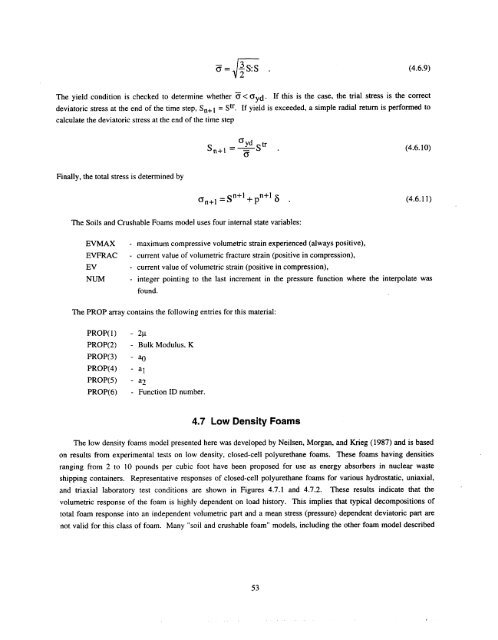II II II II II I - Waste Isolation Pilot Plant - U.S. Department of Energy
II II II II II I - Waste Isolation Pilot Plant - U.S. Department of Energy
II II II II II I - Waste Isolation Pilot Plant - U.S. Department of Energy
- No tags were found...
You also want an ePaper? Increase the reach of your titles
YUMPU automatically turns print PDFs into web optimized ePapers that Google loves.
~=$s:s . (4.6.9)<br />
J<br />
The yield condition is checked to determine whether ~ < Oyd. If this is the case, the trial stress is the correct<br />
deviatoric stress at the end <strong>of</strong> the time step, Sn+ 1 = S‘r. If yield is exceeded, a simple radial return is performed to<br />
calculate the deviatoric stress at the end <strong>of</strong> the time step<br />
(4.6.10)<br />
Finally, the total stress is determined by<br />
CT”+l =s ‘+1+pn+’ 5 .<br />
(4.6.11)<br />
The Soils and Crushable<br />
Foams model uses four internal state variables:<br />
EVMAX - maximum compressive volumetric strain experienced (always positive),<br />
EVFRAC - current value <strong>of</strong> volumetric fracture strain (positive in compression),<br />
EV - current value <strong>of</strong> volumetric strain (positive in compression),<br />
NUM - integer pointing to the last increment in the pressure function where the interpolate was<br />
found.<br />
The PROP array contains the following entries for this material:<br />
PROP(1)<br />
PROP(2)<br />
PROP(3)<br />
PROP(4)<br />
PROP(5)<br />
PROP(6)<br />
- 2p<br />
- Bulk Modulus, K<br />
-W<br />
- al<br />
- a2<br />
- Function ID number.<br />
4.7 Low Density Foams<br />
The low density foams model presented here was developed by Neilsen, Morgan, and Krieg (1987) and is based<br />
on results from experimental tests on low density, closed-cell polyurethane foams. These foams having densities<br />
ranging from 2 to 10 pounds per cubic foot have been proposed for use as energy absorbers in nuclear waste<br />
shipping containers. Representative responses <strong>of</strong> closed-cell polyurethane foams for various hydrostatic, uniaxial,<br />
and triaxial laboratory test conditions are shown in Figures 4.7.1 and 4.7.2. These results indicate that the ‘<br />
volumetric response <strong>of</strong> the foam is highly dependent on load history. This implies that typical decompositions <strong>of</strong><br />
total foam response into an independent volumetric part and a mean stress (pressure) dependent deviatoric part are<br />
not valid for this class <strong>of</strong> foam. Many “soil and crushable foam” models, including the other foam model described<br />
53
















